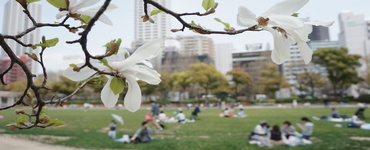Based on my son’s experience of spending a year in Japan, academic support, social connectedness, and community engagement and activities contribute to international students’ school and cultural adjustment process.
Keywords: study abroad, cultural adjustment, school adjustment, Japan
Studying abroad
With study abroad (SA) programs flourishing in countries around the world (that is before the COVID-19 pandemic hit), students studying overseas has received considerable empirical attention in the past twenty years, “particularly as a means of understanding the complexities of SA contexts” (Isabelli-García et al., 2018, p. 447). Recent SA research has focused on a number of topics, “ranging from linguistic performance on a single token such as lexical, morphological, or phonological features to nonlinguistic domains such as fluctuating identity formation that occurs abroad and development of intercultural competency” (Isabelli-García et al., 2018, p. 449). A significant part of this research has been conducted in countries where English is spoken as a first language (e.g., Australia, New Zealand, UK, the US, and Canada), linking this trend to people’s desire for mobility with English being used as the lingua franca around the world. Some of this line of inquiry have suggested that many ESL learners have limited opportunities to use English outside the classroom (Chappell et al., 2018), hindering the acquisition process of the target language as active use is essential in learning a second language (L2). Yet, as Coleman (2015, p. 38) points out, students “are [often] not the same students who return” home, and therefore language development is just one of many issues being researched in SA contexts. Studies exploring ESL learners’ school and cross-cultural adjustment processes, for example, have demonstrated that living in a foreign country with an unfamiliar language can be a stressful experience, often intensified by separation from family (Szabo et al., 2016). Adjusting to a new environment is generally facilitated by staying for a prolonged period of time in the country, establishing interpersonal relationships, and addressing mental health concerns (Wang et al., 2018; Yeh, 2003). As such, learner identity, including individual differences, motivation, and social networks, has been shown to play a crucial role in studying in a foreign environment.
Studies on international students in non-English speaking countries have highlighted the importance of social networks in studying abroad. That is, social activities and out-of-class interaction in the target language can positively influence L2 development (Paradowski et al., 2021), and students forming local relationships and getting involved in local leisure activities (e.g., sport) gradually excel in their integration and enjoyment of their intercultural experience (McManus et al., 2014). “The self-reported amount of social interaction outside of class” (Dewey et al., 2012, p. 130) seems to enhance the development of international students’ Japanese speaking skills in Japan, while stress, loneliness, and lack of progress in learning Japanese hinders the cross-cultural adjustment of international students in Japanese universities. Social support, interpersonal relationships, length of study, and mastery of the Japanese language, on the other hand, facilitate the process, although the extent of students’ adjustment tends to vary depending on their cultural background (Tanaka et al., 1994). One of the few studies examining younger learners, Li et al. (2013) found that self-efficacy, academic disengagement, alienation, and parental support play important roles in Chinese students’ adjustment to life in junior and senior high schools in Japan, while length of residence is positively correlated with language development and cultural adaptation.
With the exception of Li et al.’s study, the majority of the research on international students in Japan appears to focus on university students. Also, all of the aforementioned studies draw on questionnaire data and therefore provide somewhat limited insights into the lived experiences of international students in Japan. Responding to Dewey et al.’s (2012) proposition that “[t]o better understand relationships between identity, attitudes, motivation, social networks, and language acquisition, a more holistic picture of learners’ experiences is critical” (p. 126), the present paper is qualitative in nature and aims to provide a thick description to showcase my son’s experience of spending a year in Japan. The study is guided by the following broad research question: What are my son’s lived experiences while adjusting to life in Japan?
My son’s background
Having been born in Canada to a Japanese mom and a Swiss/American dad, my son has a fascinating and rather complicated identity, and so we decided early on to raise him bilingually (English-Japanese). Prior to spending a year in Japan, he had visited the country on several occasions and attended a Japanese primary school in the greater Osaka area for a few weeks in grades and 1 and 5. These short visits enabled him to make friends with some of the local children, and he was to a certain degree familiar with the school environment, neighborhood, and Japanese culture. At the time this study was conducted, he was 12 years old and his spoken Japanese was at an intermediate level, while his reading and writing proficiency were slightly lower.
Moving to Japan for a year
Spending a whole year in Japan at some point during our children’s formative schooling years to learn more Japanese and develop an intricate familiarity with the culture was always something my wife and I were hoping to achieve as parents. The idea was not unlike the study abroad experience of international students in English-speaking countries, except that we intended to immerse our kids in the Japanese language and culture. The opportunity arose at the end of 2017. Complications with our Australian permanent residency (PR) application meant that we had to leave Australia and apply for PR from overseas. Although somewhat unexpected, this was the perfect opportunity for us to spend a year in Japan and so my wife and three children left for Osaka in early February 2018. I was fortunate to have a flexible job (and an understanding head of school) that permitted me to teach online and therefore visit my family on several occasions.
As soon as they arrived in Japan, my wife enrolled the children in public primary school with my oldest son joining grade six. Six weeks after moving to Japan, he graduated from primary school, and a month later he commenced junior high school (grade 7). All of the subjects were taught in Japanese and moving to a different school with new teachers provided a significant challenge for him. Complicating this transition was the fact that the majority of students were Japanese and the teachers had limited experience in dealing with students from other countries. Having crossed borders and lived in different countries on multiple occasions myself (Burri, forthcoming), I was interested in my son’s experiences and challenges and I wanted to find out how he was coping with this transition and with being a foreign student at a Japanese junior high school, especially since it became apparent that he was going to receive minimal academic support from the school. Another reason for my interest was in spite of these challenges, he seemed to be genuinely excited about the prospect of attending a junior high school in Japan, and so I set out to look for factors that contributed to his school and cultural adjustment in the hope that some of the insights gained during my inquiry would make a contribution to the SA literature.
Following my son’s transition to the local junior high school—and in the spirit of some of my previous ethnographic work (Burri, 2018)—I began to carefully observe and have deliberate conversations with him about his experiences at the school and in the community. At the end of the year, I had a 30-minute chat with him with the aim of having him reflect on the entire year and to give me an opportunity to ask some questions about issues I had observed or been told about. Two weeks later, I had a similar conversation with my wife to compare her perspective with my son’s experiences and with some of the insights I had gained since his transition to the junior high school. None of these conversations were audio-recorded as they often took place spontaneously in various places (e.g., over dinner, at a café, on the train, or at school events, etc.), but I kept notes on my laptop which were then arranged thematically before writing up this article.
Adjusting to life in Japan
Initially, my son encountered several challenges at the junior high school, but academic and parental support, friendships, and community engagement and activities facilitated his adjustment. Academically, he found the testing and the frequency of the exams in some of the school subjects challenging. He also struggled with learning kanji (Chinese characters), but he was determined to catch up to his classmates. He began to practice and memorize kanji characters at home before and after school, and, somewhat surprisingly, he decided to reduce his swimming training in order to attend cram school and study Japanese language and math. He believed that going to cram school would help him do better on tests because most of the exams were memory-based. Finding the right cram school was important for my son’s academic progress. The wife of the owner and teacher of the institution was from the Philippines and therefore possessed a good understanding of the complexity of the Japanese language and the typical challenges and mistakes foreigners make when using the language. As my son explained, the academic support he received at the cram school began to pay off over the course of a few months: “I gained confidence in studying” to the extent that “the exams [at school] helped me how to study. They showed me that I could do it.”
Peer intimidation was another challenge my son faced at the beginning of the school year. My wife suspected that Japanese students were not used to having a non-Japanese student in class and that the teachers were perhaps unsure about how to address this issue. Consequently, she met with the teachers and, in an attempt to stop the bullying, she suggested that the teachers discussed with the class that each student was unique and different and thus there was no place for peer harassment in society. She viewed this to be a necessary step, given that alienation can lead to emotional stress and academic disengagement among children, especially international students (Li et al., 2013). After that conversation, the situation improved notably. My wife being a native Japanese speaker and therefore having the language proficiency to communicate with the teachers while possessing intricate knowledge of the local school culture proved to be critical in my son’s adjustment process. As he pointed out, “Mom helped me a lot at school. She talked to my teachers a lot.” Yet, he also viewed his homeroom teacher to be influential in helping him settle and catch up academically. He thought his teacher was a unique and positive person that often encouraged him. Interestingly, the teacher told us that having my son in the class gave him a new perspective on how kids learned. He also mentioned that one of the girls in class only sporadically came to school in the first few months of the new school year but then began to attend more frequently, possibly due to my son’s social nature and ability to communicate with his classmates. Given the positive social interaction with his classmates and teachers, the year in Japan was perhaps more profound than we will ever know.
Nonetheless, living in a foreign country was a lonely experience for my son in the first few months: “I didn’t really have anyone to talk to. I had mom but it wasn’t exactly the same.” As time progressed, his lonesomeness began to be mitigated by social connectedness and community engagement. He started to form strong friendships with some of the kids at school and they helped him with his schoolwork: “having friends helped me want to go to school every day. They also helped me if I didn’t know how to read or say something.” As the following statement depicts, making friends also enabled him to participate in community activities:
I can walk to school and play with friends. I can interact with people at the card game shop every Sunday afternoon. I realized that I am good at playing card games. It was fun interacting with new people and playing cards. Also, the Bible camp in August was really fun. I got to meet new people and learned about God and other people’s experiences.
Besides getting more engaged in the community, he also joined the school’s swimming club. Through joining the club he was able to meet and make new friends with children that shared a common interest: swimming. Thus, forming friendships and participating in community and sports activities facilitated my son’s adjustment. Somewhat similar to my own experience of studying abroad (Burri, forthcoming), however, the local context in which he was situated also augmented this adjustment process. He thought that being in the epicenter of an M6.1 earthquake, which resulted in a week-long school closure, and experiencing significant flooding and a serious typhoon were interesting and added to the authenticity of his 1-year stay in Japan. Not surprisingly, therefore, I observed a gradual increase in his cultural competence as his identity began to change and be “reproduced in social interaction” (Darvin & Norton, 2015, p. 37) to the extent that at the end of the year he told me that “I feel that I’m fitting in a lot.” Hence, being immersed in a specific local context while having his own social space in the local community gave my son ample opportunities to improve his Japanese proficiency and adjust his identity, which, in combination with academic and parental support, helped him overcome some of the challenges and subsequently facilitated his school and cultural adjustment in Japan.
Conclusion
My son’s experience in Japan provided evidence that adjusting to a foreign environment is not just limited to studying an additional language. Adjustment is situated in a particular context and facilitated by a number of interconnected factors, including academic support, social interaction and connectedness, and community engagement and activities. Granted, my son’s trans-cultural identity, as well as his prior knowledge of the Japanese language (Hennings & Tanabe, 2018), likely facilitated his adjustment and probably set him apart from the typical international student in an SA program. It would be interesting to hear from more parents or researchers about their experiences with raising multicultural children at home and while studying overseas (see, for example, Kouritzin, 2000, 2016). Having more of those narratives would not only be informative and possibly empower parents/guardians, but ultimately contribute to students’ adjustment and enjoyment of living in a foreign environment. Being an overseas student can be an incredibly enriching experience, often resulting in a new appreciation for diversity; something that I think is desperately needed in these challenging times we are currently facing.
References
Burri, M. (2018). Empowering non-native-English-speaking teachers in primary school contexts: An ethnographic case study. TESOL Journal, 9(1), 185-202. https://doi.org/10.1002/tesj.316
Burri, M. (forthcoming). From ESL student to teacher educator: Reflections on transnational and transcultural professional identity development. In G. Barkhuizen (Ed.), Language teachers studying abroad: Identities, emotions and disruptions.
Chappell, P., Benson, P., & Yates, L. (2018). ELICOS students’ out-of-class language learning experiences: An emerging research agenda. English Australia Journal, 33(2), 43-48.
Coleman, J. A. (2015). Social circles during residence abroad: What students do, and who with. In R. Mitchell, N. Tracy-Ventura, & K. McManus (Eds.), Social interaction, identity and language learning during residence abroad (pp. 33-52).The European Second Language Association. http://www.eurosla.org/monographs/EM04/Coleman.pdf
Darvin, R., & Norton, B. (2015). Identity and a model of investment in applied linguistics. Annual Review of Applied Linguistics, 35, 36-56. http://dx.doi.org/10.1017/S0267190514000191
Dewey, D. P., Bown, J., & Eggett, D. (2012). Japanese language proficiency, social networking, and language use during study abroad: Learners’ perspectives. Canadian Modern Language Review, 68(2), 111-137. https://doi.org/10.3138/cmlr.68.2.111
Hennings, M., & Tanabe, S. (2018). Study abroad objectives and satisfaction of international students in Japan. Journal of International Students, 8(4), 1914-1925. https://doi.org/10.5281/zenodo.1472920
Isabelli-García, C., Bown, J., Plews, J. L., & Dewey, D. P. (2018). Language learning and study abroad. Language Teaching, 51(4), 439-484. https://doi.org/10.1017/S026144481800023X
Kouritzin, S. G. (2000). A mother’s tongue. TESOL Quarterly, 34(2), 311-324. https://doi.org/10.2307/3587954
Kouritzin, S. G. (2016). Mothering across colour lines: Decisions and dilemmas of white birth mothers of mixed-race children. Journal of Multilingual and Multicultural Development, 37(8), 735-747. https://doi.org/10.1080/01434632.2015.1122604
Li, Y. X., Sano, H., & Ahn, R. (2013). Cross-cultural adjustment of Chinese students in Japan: School adjustment and educational support. International Journal of Progressive Education, 9(3), 154-168.
McManus, K., Mitchell, R., & Tracy-Ventura, N. (2014). Understanding insertion and integration in a study abroad context: The case of English-speaking sojourners in France. Revue Française de Linguistique Appliquée, 19(2), 97-116. https://doi.org/10.3917/rfla.192.0097
Paradowski, M. B., Jarynowski, A., Jelińska, M., & Czopek, K. (2021). Selected poster presentations from the American Association of Applied Linguistics conference, Denver, USA, March 2020. Out-of-class peer interactions matter for second language acquisition during short-term overseas sojourns: The contributions of Social Network Analysis. Language Teaching, 54(1), 139-143. https://doi.org/10.1017/S0261444820000580
Szabo, A., Ward, C., & Jose, P. E. (2016). Uprooting stress, coping, and anxiety: A longitudinal study of international students. International Journal of Stress Management, 23(2), 190-208. https://doi.org/10.1037/a0039771
Tanaka, T., Takai, J., Kohyama, T., & Fujihara, T. (1994). Adjustment patterns of international students in Japan. International Journal of Intercultural Relations, 18(1), 55-75. https://doi.org/10.1016/0147-1767(94)90004-3
Wang, Y., Li, T., Noltemeyer, A., Wang, A., Zhang, J., & Shaw, K. (2018). Cross-cultural adaptation of international college students in the United States. Journal of International Students, 8(2), 821-842. https://doi.org/10.32674/jis.v8i2.116
Yeh, C. J. (2003). Age, acculturation, cultural adjustment, and mental health symptoms of Chinese, Korean, and Japanese immigrant youths. Cultural Diversity and Ethnic Minority Psychology, 9(1), 34-48. https://doi.org/10.1037/1099-9809.9.1.34











